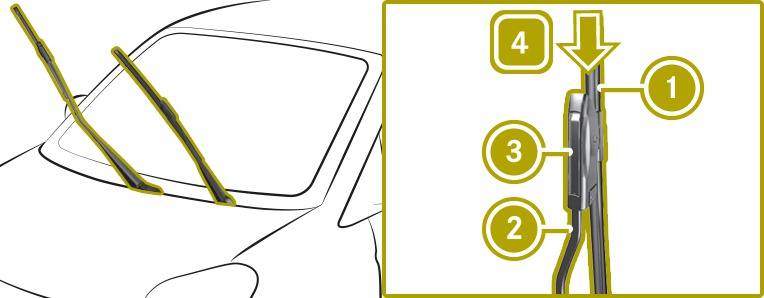- smart fortwo
- EQ fortwo
- 04/2021
A flat tyre severely affects the driving characteristics as well as the steering and braking of the vehicle.
Tyres without run-flat characteristics:
Tyres with run-flat characteristics:
Damaged tyres can cause tyre pressure loss.
Insufficient tyre tread will result in reduced tyre grip.
The risk of aquaplaning is increased on wet roads, especially when the speed of the vehicle is not adapted to suit the conditions.
Summer tyres: 3 mm
M+S tyres: 4 mm
If you cannot avoid driving over obstacles, e.g. kerbs, do so slowly and at an obtuse angle only. The wheel rims and tyres could otherwise be damaged.
Check the tyre pressure More.
Visually inspect wheels and tyres for damage.
Check the valve caps.
The valves must be protected against moisture and dirt with the valve caps specially approved for the vehicle.
Visually check the tyre tread depth and the tyre tread over the entire width.
The minimum tyre tread depth for summer tyres is 3 mm and for winter tyres 4 mm.
the vehicle becomes grounded, e.g. on a high kerb or an unpaved road
the vehicle is driven too fast over an obstacle, e.g. a kerb, speed bump or pothole
a heavy object strikes the underbody or suspension components
In situations such as these, damage to the body, underbody, suspension components, wheels or tyres and high-voltage battery components may not be visible. Components damaged in this way can unexpectedly fail or, in the case of an accident, may no longer absorb the resulting force as intended.
Modification work on the brake system and wheels is not permitted. The use of spacers or brake dust shields is not permitted. This will invalidate the general operating permit for the vehicle.
Check the wheels and tyres for damage at least once a month, as well as after driving off-road or on poorly surfaced roads.
Run in new tyres at moderate speeds for the first 100 km. The tyres only attain their maximum performance after this distance.
If you drive too fast with snow chains, they can break, injure other persons, and damage the vehicle.
If you have fitted snow chains to the front wheels, they may drag against the vehicle body or chassis components.
If snow chains are fitted to steel wheels, the wheel trims can be damaged.
For safety reasons, smart recommends that you only use snow chains that have been specially approved for your vehicle by smart. Further information can be obtained at a smart Centre or a qualified specialist workshop.
Observe the country-specific requirements.
Use only snow chains approved for smart.
Fit snow chains on both rear wheels.
Use snow chains only on snow-covered roads.
When driving with snow chains fitted, do not exceed the maximum permissible speed of 50 km/h.
Observe the notes on operating fluids More.
Windscreen washer concentrate is highly flammable. If it comes into contact with hot components in the front compartment, it may ignite.
Unsuitable windscreen washer fluids may damage the plastic surface of the exterior lighting.
Do not use distilled or de-ionised water. Otherwise, the fill level sensor may give a false reading.
Above freezing point: e.g. MB SummerFit
Below freezing point: e.g. MB WinterFit
For the correct mixing ratio, refer to the information on the antifreeze container.
Mix the washer fluid with windscreen washer fluid all year round.
Windscreen washer concentrate is highly flammable. If it comes into contact with hot components in the front compartment, it may ignite.

 up using the tab.
up using the tab.  and close it tightly.
and close it tightly. For information on windscreen washer fluid and antifreeze, see "Technical Data" More.
If the windscreen wipers begin to move while you are changing the wiper blades, you can be trapped by the wiper arm.

 of bracket
of bracket  in the direction of the windscreen
in the direction of the windscreen  . The catch tab will be released from the bracket. Pull the windscreen wiper blades away from the wiper arm.
. The catch tab will be released from the bracket. Pull the windscreen wiper blades away from the wiper arm.  in the direction of arrow
in the direction of arrow  until the windscreen wiper blade fastening hook is exposed.
until the windscreen wiper blade fastening hook is exposed. 
 into bracket
into bracket  of wiper arm
of wiper arm  in the direction of arrow
in the direction of arrow  .
. The windscreen wiper blade will engage.
 onto the windscreen.
onto the windscreen.